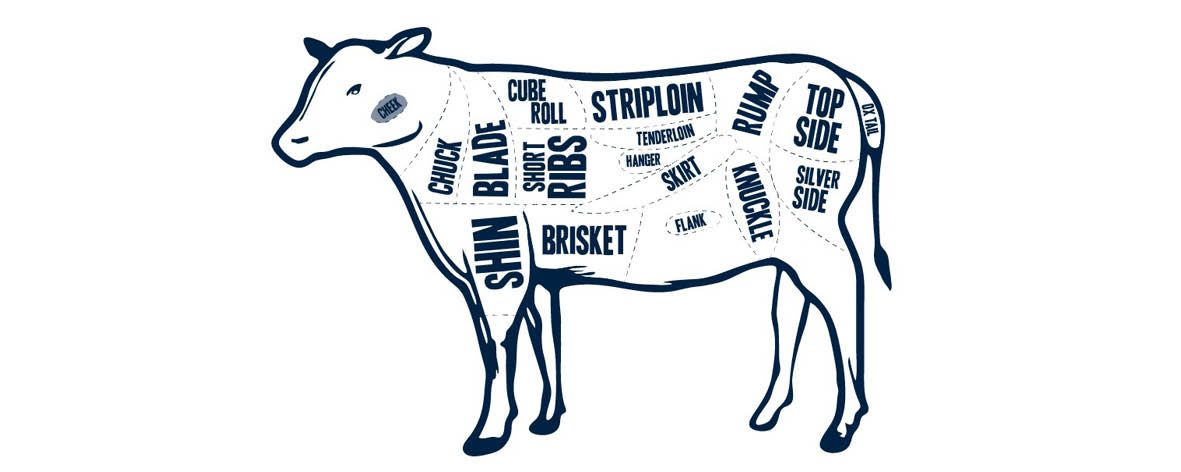All you need to know about beef cuts … our guide

If you don’t know the difference between silverside and top side, or you think skirt and hanger are purely fashion-related terms, it’s time to beef up your knowledge with our guide to beef cuts.
Cheek
As a hard-working muscle, this cut is best suited to moist, slow cooking methods – think curries, casseroles and stews. It also holds its shape well when cooked whole so is good for dishes like our Slow-Cooked Beef Cheeks with Red Wine Jus or Sticky Braised Beef Cheeks.
Chuck
Made up of multiple muscles, chuck is a well used area so contains a great deal of connective tissue. Popular for its balance of meat and fat, the chuck offers ribs, roasts and steaks and suits a range of cooking methods. Perfect for curries and stews with great full flavour and a fantastic gelatinous texture.
Blade
Derived from the shoulder region of the animal, blade is flavoursome and versatile. It contains several muscles with layers of fat and connective tissue and performs well as a slow braise or roast.
Rib Eye Roll
Also known as the “cube roll”, the rib eye roll is prepare dfrom the forequarter, running along the back of the animal between the chuck and the striploin. This is where scotch fillet comes from, as well as rib roast and rib cutlets. As this area is a support muscle these cuts are tender, tasty and moist.
Short Ribs
Taken from the forequarter after the brisket is removed and made up of the rib bone and layers of rib meat and fat, these are full of flavour and fall-off-the bone tender. Grill or slow roast them for a succulent beef dish.
Striploin
Located along the spine in the hindquarter running from the ribs to the rump, the striploin sits above the tenderloin. This is home to sirloin and t-bone steak.
Tenderloin
A long and lean muscle, this is the most tender cut of beef available. The tenderloin is the source of tenderloin steak or filet mignon, and is a component of the T-Bone and scotch fillet steaks.
Hanger
Also known as “thick skirt” there is only one hanger per animal – it hangs from the last rib, attached to the diaphragm. It is not a particularly tender cut but it does have a robust flavour and is best cooked quickly over high heat.
Skirt
Located just below the ribs, skirt steaks are versatile and full of flavour. When cooked on high heat, the characteristic marbling imparts outstanding flavour.
Brisket
Derived from the underside chest area between the front legs, brisket is a well exercised muscle with ample connective tissue. Brisket is best suited to slow cooking methods.
Flank
A long flat steak taken from a single muscle beneath the loin in the abdominal area. Flank steak is extremely versatile. Perfect for thin slicing for a stir-fry, flank steak also performs extremely well under slow-cooking conditions. After slow-cooking, this beef cut can be shredded with a fork and added to burritos or salads.
Rump
The rump is a boneless five-muscled primal that sits between the sirloin and topside. Extremely versatile, rump can be sliced whole into rump steaks or into a range of cuts with varying textures and tenderness.
Shin
Because it comes from a well-exercised muscle, shin has little fat and abundant connective tissue. Bone-in is often cut across the bone into osso-buco whilst boneless shin is prepared from either the shin area or the heel muscle in the silverside. Shin suits moist low, slow cooking to allow the connective tissue to tenderise while enriching with flavour. The resulting meat is tender and rich in flavour.
Knuckle
The knuckle sits above the knee joint at the front of the hind leg. Made up of three muscles, it's prepared from the thick flank by removing the cap muscle and associated fat. Eye of knuckle is the lean, centre weight-bearing muscle with little connective tissue. Used for roasting or preparing further into medallions, it produces a notably tender and delicious result when cooked with moist, slow methods.
Top Side
Topside comes from the inside of the hind leg, between the thick flank and the silverside. Topside is extremely lean and performs best when diced for slow-cooking in a hearty casserole or braise.
Silverside
Silverside comes from the outside of the rear leg and sits between the knuckle and the topside. Made up of five distinct muscles, it’s named after the silver wall of connective tissue that sits on the side of the cut, which is removed before cooking. As a well-exercised group of muscles, it needs gentle, moist cooking. The resulting texture melts off the fork.
Ox Tail
The ox tail cut starts at the base of the spine. The fat is trimmed and the last two to three tail bones removed, before being cut into short joints. Slow cooking this distinctive cut brings out a robust, full-bodied flavour while creating meltingly tender meat.

